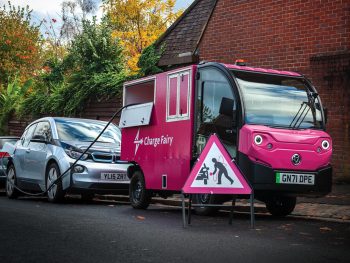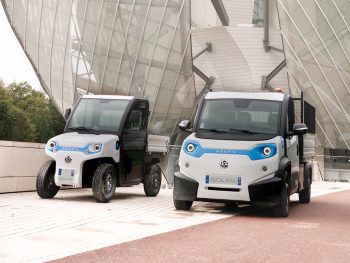Getting the right specification on a light commercial can make or break a fleet’s operations efficiency and profitability. Matt MacConnell explains more.

When it comes to kitting out an LCV, there are plenty of options suitable for various services — from those who run refrigeration transport companies, to those who need van racking. With more ULEZ areas popping up around the UK, many companies are now considering the switch to EVs. This scenario, however, has fleet operators wondering whether van racking can be mounted to the floor of an EV due to the batteries – and also whether powered items such as refrigeration units or tail-lifts will affect the EV’s range. It also has fleets researching what vehicles or accessories are available and whether they suit their needs.
Bradshaw EV supplies a range of small electric vehicles. Its new vehicle, the all-electric Goupil G4, has become one of the company’s best-selling models due to its versatility, as the bodies at the back can be switched in a modular manner. Buyers can choose from 10 body options such as a pickup, cage body, box van, leaf collector, pressure washer and a high-tip waste collector.
“The G4 chassis body provides a blank canvas to build your ideal vehicle,” says Ramsy Labassi, Bradshaw EV marketing manager. “The opportunities are almost limitless and we are proud to offer our customers the opportunity to create their own unique electric vehicles tailored to their exact requirements.” The G4 can carry a payload of up to 1,370kg while equipped with the 9kWh battery option, returning between 50 to 101 miles. Buyers can choose from four battery options: 9kWh, 11.5kWh, 14kWh and 15.4 kWh.

The G4 is road-legal, available in left-hand drive and, thanks to its 3,675mm length and 1,574mm width, compact.
“We were highly impressed with how seamlessly we could convert the vehicle’s body without compromising the quality or performance,” says Andrew Bennett, owner of Classic French Vans and a customer of Bradshaw.
“Many companies we met with simply couldn’t provide this bespoke service, or were too expensive. However, the G4 was the perfect vehicle at the right price.”
Bradshaw EV says that the G4 is a popular choice for those looking for an environmentally friendly alternative to an internal combustion-engined vehicle and with it being electric, noise levels are low, making it ideal for residential areas and commercial applications.
How low can you go…
When it comes to Luton vans, Devon-based Trucksmith spotted room for innovation 30 years ago. Luton vans were often square-fronted, which resulted in higher fuel consumption. They also often had high floors, which could make loading and unloading difficult. Trucksmith’s LoLoader product includes an aerodynamic Luton pod, has a floor height of 550mm, allowing for easier loading and unloading and there’s no need for a ramp or a lift. The LoLoader has a payload of 1,200kg, which includes an allowance for both fuel and driver. Dimensions of the interior body are 4.1m in length and 2.2m in height, and where air suspension is specified, the 550mm floor height can be dropped to 450mm.
There are a quite few options available when scoping a vehicle, such as a 90° door retainer, a single personnel door instead of a double rear door, roll-in tailgate, LED lighting, a ferry roller, a double side-door, plywood lining, a large rear step, a roller shutter and a tail lift. Fleet operators can also choose from various safety features such as a full-height bulkhead and reversing cameras.
According to Trucksmith: “The Trucksmith LoLoader remains the game-changer it was designed to be. With its low-loading ability, durability, impressive payload, comfort, safety features and fuel efficiency, it is the ultimate choice for businesses looking to optimise their transport operations.”
The company operates across more than 64,000ft2 and is continuously enhancing efficiency and build quality. It is also an approved converter for Renault UK, Renault Trucks, General Motors, Opel and Vauxhall, Nissan, Peugeot, Citroën, Toyota and Fiat.
Getting the perfect spec online
When it comes to cars, it’s easy to hop online nowadays and configure a model via the manufacturer’s website. Configurators usually give a rundown of costs and additional features can be added, with the specifications of the vehicle clearly outlined.
In response LCV body builder Alloy Bodies has introduced a body configurator to its website that allows stakeholders in the commercial vehicle buying process to see all the variations of both chassis and body conversions that are available.
“We needed a more dynamic and visual way to offer our conversions to customers over the traditional images and CAD diagrams,” reveals sales director, Anthony Clayton. “Our experience tells us when an owner, operator or fleet manager is looking at what conversion options are available to them, they will be heavily influenced by the supplying dealer and the limitations of that chassis brand or model.
“With any sale, captivating the customer’s attention visually is key, and with conversions this is even more important,” adds Clayton. “Our configurator allows customers to fully customise their requirements with comprehensive options on internal load restraint, rear closures, tail-lifts and ancillary electrics. We can also provide specific customer login access to a brand-specific dashboard within the configurator where they can generate quotations instantly. Our customers want information, specifications and prices as quickly as possible, and our software facilitates this.”
The pressure is on, especially for smaller companies, when it comes to whatever deadline for phasing out petrol and diesel engines the government chooses. The move to electric from ICE vehicles should be done step-by-step, but companies that wish to move may be wondering if the extra electric load on the EV could affect its range and cause additional downtime. Alloy Bodies has built several electric chassis cabs and it is beginning to utilise ePTO to power equipment and use solar recharge systems to maintain separate batteries for tail-lifts, cranes and ramps.

For companies that provide a passenger service, the focus will primarily be on vehicles that can maximise passenger numbers. Minibus and fleet supplier PHVC has this covered with its 15-seat Ford E-Transit. The conversion was completed by GowringsVersa Mobility and was subsequently improved by Ford UK.
Features include an electric step as standard, while fleet managers can spec an electronic lift with wheelchair accessibility — PHVC claims that it can reduce running costs by up to 40%, compared with ICE models, thanks to lower maintenance expenses due to fewer moving parts. It also features a 400V battery with 68kWh usable power, delivering a range between 166 and 196 miles when fully charged. The E-Transit has four different driving modes: Eco, which improves energy by up to 10%; Low, which increases braking regen; Normal, which balances everyday driving, and Slippery, which offers further traction over wet or icy surfaces.
PHVC says: “In a world grappling with the urgent need to address climate change and reduce carbon emissions, the automotive industry is undergoing a transformative shift towards cleaner and more sustainable transportation solutions.”
Everyday products that assist fleets in their daily duties are constantly being improved to save fleet managers money on fuel, or prevent buying a product twice due to its lower durability. One example is Van Guard’s ULTIBar Trade steel roof bar, which has the steel bar strength without the additional weight. It uses a streamlined profile to aid aerodynamics and reduce wind noise. It comes with a three-year warranty, is coated with a Magnelis coating for improved corrosion resistance and is designed to carry 60kg per bar.

